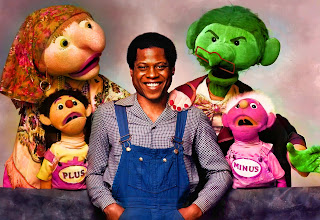In 1970s, Cable TV was in its tenancies that in Tennessee Ohio there was an idea by Warner Cable for an experimental two way multiplatform cable television system that played a significant role in American interactive television. This experiment was called Qube Network.
Qube introduced viewers to several concepts that became central to the development of modern television. Pay-per-view programs, special interest cable television networks and interactive services.
On December 1st, 1977, a breakthrough show began airing a new show called Pinwheel show was similar to Sesame Street with live-action skits, mixed in with shorts from an abandoned animatior. The show was met with immense popularity that it's cable provider Channel 3 at the time would go as far as renaming the network to Pinwheel.
The show starred Kim played by Arline Miyazaki, Sal played by Betty Rozek, Smitty played by Dale Engle. Sal And Smitty were an elderly couple who ran a local newspaper company called The Daily Noodle. One of Smitty's obsessions was getting a photo of the elusive Emerald Bird with the intention of placing it on the front page of The Daily Noodle.
This was a long running gag that saw Smitty constantly missing off on the opportunity to capture the bird. Another character was Jake played by George James who enjoyed music and his hobby was collecting unusual sounds in small boxes.
Franci was another of the human characters and she was an artist in the show as well as a storyteller who was eventually phased out. The last of the human characters was Coco and she was a French mime who was played by C.C. Loveheart.
As for the puppet characters, there was Aurelia who was an Bohemian style character who owned by the Pinwheel house. She had red coloured hair, olive green eyes, purple lips frequently colourful headscarves and large hoop earrings as well. Her personality was friendly and bubbly but firm when needed.
Her nephews were Plus and Minus, they were twin boys who lived in the attic room. The colour scheme of the twins were very wild and the exact opposite of Aurelia. Plus had black hair and orange skin while Minus had white hair and purple skin. As for their personalities, Plus was very upbeat and enthusiastic while Minus was more thoughtful and easily discouraged.
A recurring sketch was Minus's attempt to board a spaceship Plus distracting caused him to miss take off. The twins favourite thing was Goncha Lash which was a combination of tag and, hide and seek and this game went on eternally.
Another character included Silas the Snail who was always on his way to the annual Snail gathering which he would never be able to visit because he was so slow. He barely made it out of the garden. He would also give a message to the viewers to slow down and enjoy life and saying getting there is half the fun.
There were also many others Ebenezer T. Squint was a grumpy green-skinned resident who lived in the basement storage. He would always pretend to be grouchy and mean but in reality he enjoyed being part of the house activities.
Luigi O'Brien was a produce salesman who had a small vegetable stan at the back of the Pinwheel house. All the produce he sold could talk and sing and had their own personalities. They were usually referred to as their vegetable or fruit names.
Other characters included Molly the Mole, Herbert and Lulu as well who would get occasional visits from the bird like aliens Tirka, Gorkle and Woofle from the Planet Zintar.
Most of the live-action scenes took place in or around the boarding style house called the Pinwheel house. It actually featured a Pinwheel in one of the pieces. Live actors would frequently interact with the puppet characters. They would discuss topics, learn lessons, explore numbers and all the characters lived and worked within the Pinwheel house.
Warner's Pinwheel channel was hugely popular and clearly saw a demand for this type of children's entertainment with an educational aspect so when they purchase the Warner Communications Satellite it was only natural to rebrand the channel to Nickelodeon.
With the Nickelodeon rebrand came the reformat of the Pinwheel show now into hour long episodes typically shown in 3 to 5 hour blocks. This format would eventually become Nick Jr.
Pinwheel had a total of 7 seasons and 260 episodes many of which are poorly documented and the program never saw a VHS or DVD release. The show was produced from 1987-1994 and reruns would continue until 1994.
It was still the longest running show by hours aired and episodes released combined in the history of the network. It was Nickelodeon's first show and became the rise of the brand. It's not what brought the network to its true potential.
Children's program that revolved around education were becoming saturated and Nickelodeon moved to more scripted teen focused content for a new generation of kids and Nickelodeon was not afraid to ride the wave.



No comments:
Post a Comment